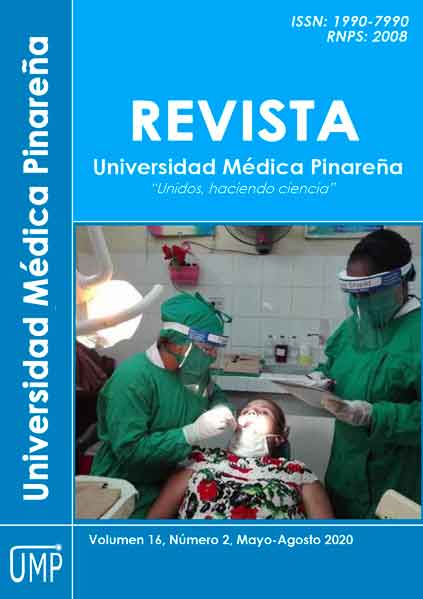Recurrent mumps behavior in pediatric patients
Keywords:
Parotid Gland, Mumps, Parotitis, Stomatognathic Diseases.Abstract
Introduction: the onset of recurrent mumps occurs with high frequency toward school age, tending to spontaneously remit just before puberty or adolescence.
Objective: to characterize the behavior of recurrent mumps in pediatric patients treated at Pepe Portilla Provincial Pediatric Hospital during 2019.
Methods: a descriptive, longitudinal and retrospective observational study was conducted in patients with recurrent parotitis during 2019. The target group consisted of 47 patients, choosing 29 through a simple random sampling. Data were collected by means of a data collection form. Descriptive statistics was applied, respecting the bioethical principles.
Results: the age group from 1 to 5 years old (44, 8 %) and male sex prevailed (55, 2 %) with mild (41, 4 %) and moderate (37, 9 %) recurrent mumps and unilateral affectations (89, 7%); 44,8 % of patients presented between 2 and 5 recurrent events per year. As personal pathological history, it was found predominance of patients without previous history (48, 3 %), allergic and respiratory diseases (34, 4 %); 58, 6 % of patients were from urban areas. As for the time of year recurrences, the winter season was found to be the predominant one (55, 2 %).
Conclusions: Male preschoolers between 1 and 5 years old, with allergic and respiratory history, coming from urban populations were prone to develop recurrent parotitis patterns. Unilateral affectations, as well as mild patterns were common.
Downloads
References
2. Gonzalez Lagunas J, Ferrer Fuentes A. Self-induced parapharyngeal and parotid emphysema: A case of pneumoparotitis. Oral and Maxillofacial Surgery Cases [Internet]. 2017 [citado 10/12/2019];3(2017):e81-e85. Disponible en: http://dx.doi.org/10.1016/j.omsc.2017.06.002
3. Gascón-Rubioa MC, Vereas-Martínez A, Ubis Rodríguez E. Parotiditis crónica recurrente juvenil. O.R.L. ARAGON [Internet]. 2016 [citado 10/12/2019];19(2):18-19. Disponible en: https://dialnet.unirioja.es/servlet/articulo?codigo=5781282
4. López-Perea N, Masa-Calles J, Torres de Mier MV, Fernández-García A, Echevarría JE, De Ory F, Martínez de Aragón MV. Shift within age-groups of mumps incidence, hospitalizations and severe complications in a highly vaccinated population. Spain, 1998–2014. Vaccine [Internet]. 2017 [citado 10/12/2019]; 35(2017):4339–4345. Disponible en: http://dx.doi.org/10.1016/j.vaccine.2017.06.075
5. González Benavides A, Vaquero Íñigo I, Mendizábal Díez M, Martínez Merino M et al. Parotiditis crónica recurrente juvenil. Rev Pediatr Aten Primaria [Internet]. 2015 [citado 10/12/2019]; 17:147-149. Disponible en: http://scielo.isciii.es/scielo.php?script=sci_arttext&pid=S1139-76322015000300015
6. Ramakrishna J, Strychowsky J, Gupta M, Sommer DD. Sialendoscopy for the management of juvenile recurrent parotitis: A systematic review and meta‐analysis. The Laryngoscope [Internet]. 2015 [citado 10/12/2019]; 125:1472-9. Disponible en: https://onlinelibrary.wiley.com/doi/abs/10.1002/lary.25029
7. Zamora Linares CE. Aspectos clínicos y evolución de la parotiditis recurrente infantil. Rev Cuba Pediatr [Internet]. 2015 [citado 10/12/2019]; 87(2):167-174. Disponible en: http://www.scielo.sld.cu/scielo.php?script=sci_arttext&pid=S0034-75312015000200004
8. Capaccio P. .Canzi P, Gaffuri M, Occhini A, Benazzo M, Ottaviani F, Pignataro L. Modern management of pediatric obstructive salivary disorders: long-term clinical experience. Acta Otorhinolaryngol Ital [Internet]. 2017 [citado 10/12/2019]; 37:160-167. http://dx.doi.org/10.14639/0392-100X-1607
9. Papadopoulou-Alataki E, Chatziavramidis A, Vampertzi O, Alataki S, Konstantinidis I. Evaluation and management of juvenile recurrent parotitis in children from northern Greece. Hippokratia [Internet]. 2015 [citado 10/12/2019]; 19(4):356-359. Disponible en: https://www.ncbi.nlm.nih.gov/pmc/articles/PMC5033148/
10. Gellrich D, Bichler M, Reichel CR, Schrötzlmair F, Zengel P. Salivary Gland Disorders in Children and Adolescents: A 15-year Experience. Int Arch Otorhinolaryngol [Internet]. 2020 [citado 10/12/2019]; 24:e31–e37. Disponible en: https://www.ncbi.nlm.nih.gov/pmc/articles/PMC6952288/
11. Sitheeque M, Cocheiro R, Sivachandran Y, Varathan V, Ariyawardana A, Ranasinghe A. Juvenile recurrent parotiditis: Clinical, sialographic and ultrasonographic features. Inter J Paedia Dentis [Internet]. 2009 [citado 10/12/2019]; 17:98-104. Disponible en: https://onlinelibrary.wiley.com/doi/abs/10.1111/j.1365-263X.2006.00804.x







